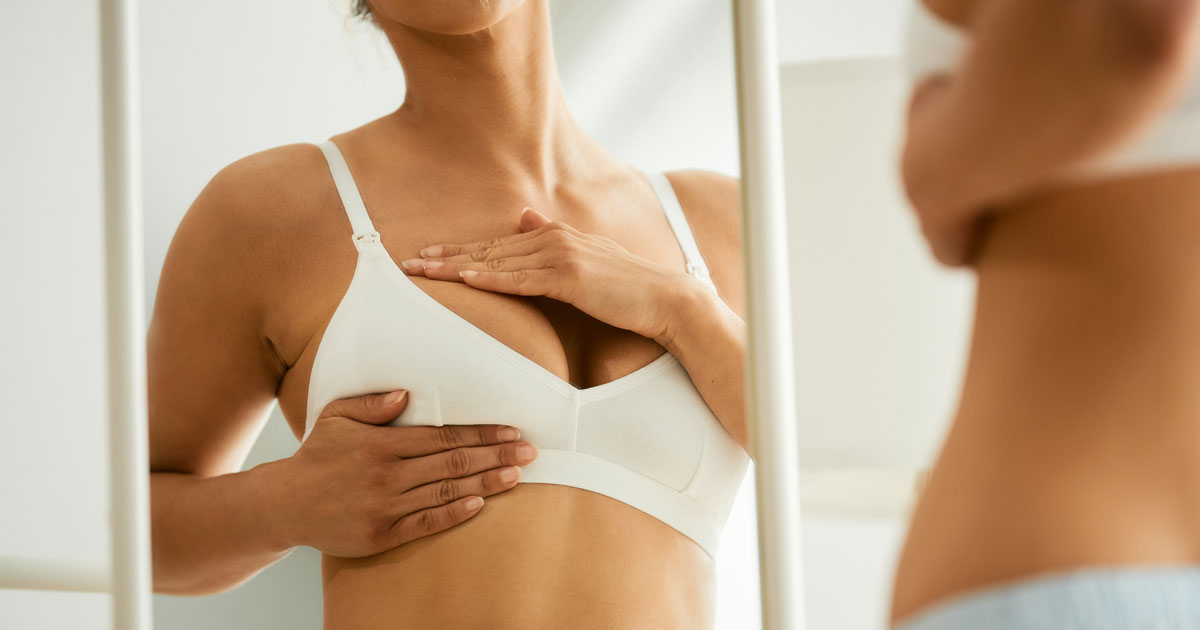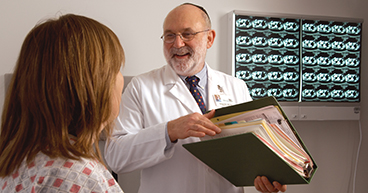
Seeing your doctor for regular breast cancer screenings is an important way to reduce your breast cancer risk. But some women may notice changes in the size, shape or appearance of their breasts between routine doctor visits and checks.
It’s a good idea to report any suspicious lumps or breast changes to your physician right away, because some signs of breast cancer may be visible when you shower, look in the mirror or perform other activities. Doing so may help catch cancer in its earlier stages, when it’s easier to treat.
Keep in mind: While most breast cancers occur in women, men account for about one out of every 100 cases annually in America. To help you recognize potential indicators of breast cancer, this article breaks down the following warning signs that merit medical attention:
- Asymmetry (when one breast appears bigger than the other)
- Flaky skin on the breast
- Redness or a rash on the breast
- Orange peel texture on the breast skin
- Nipple discharge
- Lump in the breast or armpit
- Breast dimpling
- Nipple that inverts or changes direction
- High-Risk Breast Cancer Programs at City of Hope
If you’re interested in learning more about the diagnosis and treatment of breast cancer or want a second opinion on your diagnosis and treatment plan, call us or chat online with a member of our team.

Asymmetry
Breast cancer occurs more frequently in the left breast than the right, and when that occurs, the disease tends to be more aggressive. In fact, the left breast is more than 20 percent more likely to develop cancer than the right, according to a study published in the journal of the American Association for Cancer Research.
That’s one reason that asymmetry may be a red flag for cancer. Slightly different-sized breasts don’t pose a higher cancer risk, but if your breasts are significantly different in size, it could be a sign of cancer.
Flaky skin on the breast
Breast or nipple skin that’s red, dry, flaking or thickened may be another sign of breast cancer. Some women with breast cancer experience kin scaling or peeling under the breasts, but these are also common symptoms of eczema (atopic dermatitis). If you notice these skin conditions, it’s important to seek medical attention to determine the cause.
In some cases, these skin changes are signs of a rare form of cancer called Paget’s disease of the breast, which affects less than 4 percent of women with breast cancer, according to the National Cancer Institute (NCI). Paget’s forms in the nipple and areola (the darker, pigmented skin surrounding the nipple).
Paget’s differs from other forms of breast cancer in that tumor cells develop in the skin of the breast, instead of inside the breast. The disease typically affects only one breast, and the symptoms may come and go. In addition to red, dry, flaky, peeling, scaly or thickened skin on the nipple or surrounding tissue, other symptoms include:
- Itching or tingling in the nipple or areola
- Yellow or bloody discharge
- A nipple that appears to be flattened or inverted, meaning it caves inward
Redness or a rash on the breast
If you’ve been diagnosed with inflammatory breast cancer, you may notice breast redness or a rash on the breast. This type of cancer is rare, comprising less than 5 percent of all breast cancers in the United States. It occurs when cancer cells block the lymph vessels, which carry lymph fluid and white blood cells throughout the lymphatic system, causing red, swollen and dimpled breast skin that may look like a rash.
Only 15 percent of people diagnosed with inflammatory breast cancer have a lump, and mammograms don’t always pick it up. The redness, rash and swelling it causes are also easily mistaken for breast infections, injuries or skin conditions. That’s why it’s important to ask a doctor to check such symptoms because this form of cancer is aggressive and fast-growing.
An orange peel texture on the breast skin
If the skin of your breast feels thicker and looks like an orange peel, have it checked right away. This may be caused by an infection. But pitting or bumpy breasts that resemble the skin of an orange are also a potential sign of Paget’s disease.
When caught early, Paget’s may be treated with surgery (a mastectomy or breast-conserving lumpectomy). The five-year relative survival rate for U.S. women with Paget’s disease between 1988 and 2001 was 82.6 percent, according to the NCI.
Nipple discharge
It’s unusual for pregnant or breast-feeding women to experience nipple discharge, sometimes for two to three years after nursing has stopped. It may also result from other, benign non-cancerous conditions.
But you should discuss any type of nipple discharge with your doctor because it may indicate cancer. Discharges that are clear, bloody or contain pus are possible early warning signs for certain types of cancer, especially if they occur in only one breast and are spontaneous and persistent, and a lump is also present.
A lump in the breast or armpit
A breast lump or mass is the most obvious and well-known potential indicator of breast cancer. A lump in the breast may be visible to the eye or felt with your hands during a self-breast exam. But lumps or areas of swelling around the breast, under the armpit or near the collar bone may also be signs of cancer.
A breast cancer lump often feels like a pea- or marble-shaped mass just under the skin. In some people, it may resemble a ridge rather than a bump. Often, they’re hard and painless, but some cause discomfort.
Performing regular self-exams once a month may help you identify suspicious lumps. But it’s a good idea to have a doctor check out any new ones right away. If it does turn out to be cancer, the sooner it’s diagnosed, the better.
Breast dimpling
Dimpling in the skin of the breast may be a sign of invasive lobular carcinoma (ILC), a common type of breast cancer. It’s sometimes hard to tell the difference between breast dimpling or stretch marks, so you should seek medical attention if you see signs of either.
ILC is the second-most common type of breast cancer, accounting for up to 10 percent of all cases, after invasive ductal carcinoma (IDC). ILC starts in lobules—glands in the breast that make milk—then spreads to nearby breast tissue.
In one in five women with ILC, both breasts are affected. ILC is harder to detect on mammograms and other exams than IDC, which accounts for about four in five cases.
Nipple that inverts or changes direction
Breast cancer sometimes causes nipples to turn inward—a condition sometimes known as inverted nipple or nipple inversion—or change direction. Between 10 and 20 of every 100 Americans experience inverted nipples, which may occur with aging and benign breast conditions in men and women alike.
But if you notice changes in your nipple—including the nipple turning inward, pulling to one side or changing direction—it may be a symptom of breast cancer, and you should get checked by your health care team.

The City of Hope High-Risk Breast Cancer Programs
One in eight women will develop breast cancer in her lifetime. But, for some women, the odds of developing the disease are even greater. These women are at high risk of developing cancer for a variety of reasons, including:
- A family history of cancer, especially breast and ovarian cancers
- Inherited mutations in BRCA1, BRCA2, RTPEN and/or TP53 genes
- Tobacco use
- Obesity
- History of alcohol use or abuse
- History of radiation therapy treatment before the age of 30
- Hormone replacement therapy
- Timing of prior pregnancies
- History of breastfeeding
- Early or late menopause
- Sedentary lifestyle
- Abnormalities in breast tissue
- Age
Today, advances in genetics, genomics, screening and greater awareness of potential causes of breast cancer have allowed women at high risk to reduce their chances of developing breast cancer.
At City of Hope, our High-Risk Breast Cancer Program offers personalized services for women who know they’re at risk for breast cancer or may be concerned about their likelihood of developing the disease.
Our High Risk Breast Cancer Programs are available at:
Our services include:
Genetic counseling to assess your inherited risk and determine whether genetic testing is recommended
Cancer screening with digital breast tomosynthesis or 3D mammography, ultrasound and breast MRI
Risk reduction to help identify risk factors you can control and help you develop lifestyle strategies to reduce your risk
At City of Hope, we recognize that no breast cancer patient is the same. That’s why our diagnosis and treatment programs are personalized. Our experts have extensive experience with both early-stage and complex breast cancers, including triple-negative and inflammatory, and their training and expertise allows them to quickly diagnose breast cancer and tailor a treatment plan to each patient’s unique needs.
If you’re interested in learning more about the diagnosis and treatment of breast cancer and would just like to speak with someone at City of Hope, call us or chat online with a member of our team.


